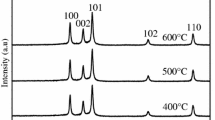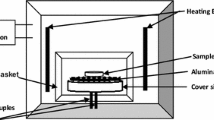Abstract
The electrical behaviour of ZnO varistors is controlled by the characteristics of the ceramic microstructure which depends strongly on the properties of the initial powder. This paper describes a study of the effect of different chemical methods to synthesise doped ZnO powders. The ceramic powders were synthesised by the following routes: a) classical mixing of oxides (for comparison purposes), b) aqueous solution of inorganic salts and c) hydrolysis and polycondensation of metalorganic compounds in an organic solvent. The physicochemical characteristics of these powders were evaluated using a scanning electron microscope and thermoanalytical instrumentation. Standard spray drying technology was used to pelletise the powders to obtain an agglomerated powder suitable for uniaxial pressing. The discs were sintered in an electric furnace under air atmosphere using several temperature programmes. The ceramic microstructure was characterised using SEM and X-ray diffraction. The effects of powder processing route on sintering and microstructural development are discussed. Powders prepared by the metalorganic route exhibited somewhat lower sintering temperatures than conventional powders. However, the rate of sintering was slower for metalorganic and aqueous solution powders. These observations were related to powder morphology. The ZnO−Bi2O3−CoO system exhibited the best varistor characteristics as it was expected, whereas the binary systems supported much lower voltages at low currents than ternary systems.
Similar content being viewed by others
References
L. Levinson and H. Philipp, Zinc oxide varistors—A review. American Ceramic Society Bulletin 65(4), 639–646 (1986).
M. Matsuoka, Non-ohmic properties of zinc oxide ceramics. Japanese J. Appl. Physics 10(6), 736–746 (1971).
Transient voltage suppression devices; Published by Harris Semiconductor, Publication N0 DB450.2 (1992).
T. Asokan and G. Iyengar, Studies on microstructure and density of sintered ZnO based varistors. J. Mat. Sci. 22, 229–236 (1987).
Y. Chen, L. Shen, and L. Wu, Grain growth process in ZnO varistors with various valence states of manganese and cobalt. J. Appl. Phys. 69(12), 8363–8367 (1991).
J. Kim and T. Yamaguchi, Effect of bismuth oxide content on sintering of zinc oxide. J. Amer. Ceram. Soc. 72(8), 1541–1544, (1989).
J. Kim, T. Kimura and T. Yamaguchi, Sintering of Sb2O3 doped ZnO. J. Mat. Sci. 24, 213–219 (1989).
J. Kim and T. Kimura, Sintering of zinc oxide doped with antimony oxide and bismuth oxide. J. Amer. Ceram. Soc. 72(8), 1390–1395 (1989).
J. Wong and W. Morris, Microstructure and phases in non-ohmic ZnO-Bi2O3 ceramics. J. Appl. Phys. 51(8), 4453–4459 (1980).
V. Keasevec, M. Prontelj, and M. Galic, Transmission electron microscope study of antimony doped zinc oxide. J. Amer. Ceram. Soc. 74(4), 760–766 (1991).
J. Kim, T. Kimura, and T. Yamaguchi, Microstructure development in Sb2O3-doped ZnO. J. Mat. Sci. 24, 2581–2586 (1989).
Author information
Authors and Affiliations
Rights and permissions
About this article
Cite this article
Puyané, R., Toal, F. & Hampshire, S. Production of doped ZnO powders for varistor applications using sol-gel techniques. J Sol-Gel Sci Technol 6, 219–225 (1996). https://doi.org/10.1007/BF00402692
Received:
Accepted:
Issue Date:
DOI: https://doi.org/10.1007/BF00402692




